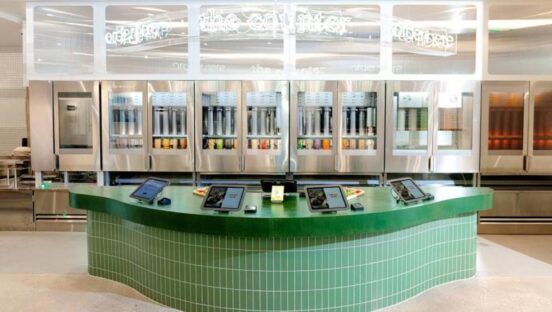As sweetgreen sought growth, CEO Jonathan Neman and his team questioned why food quality seems to decrease as brands scale. The group discovered that a lot of what the customer values around experience is stripped away for the sake of standardization.
The better-for-you fast casual felt there didn’t have to be sacrifices. And the way to do that is through technology, specifically automation. Earlier this year, sweetgreen opened its first restaurant equipped with an Infinite Kitchen, a robotic production line that prepares 100 percent of orders.
The brand still makes ingredients from scratch inside the restaurant. But now, instead of human hands assembling bowls on the front and digital makelines, workers load the Infinite Kitchen, which has an “incredibly high” throughput, Neman said.
“Our detractors in the business, if you look at our NPS, have always been around portioning, accuracy, and timeliness. This solves for all of those things,” Neman said at the 43rd Annual William Blair Growth Stock Conference. “I think what’s really great about it, it’s transformational. Not only what it will do from a labor perspective, obviously, there will be less people working in the restaurant and the jobs will be better. I think what’s most shocking are the second-order effects in terms of the overall experience. How much better it feels. when you’re in the store as well as the consistency and quality of the product.”
The first Infinite Kitchen in Naperville, Illinois, has been open for less than a month, but sweetgreen couldn’t be more pleased, Neman said. Although it’s early and the fast casual is still learning, the CEO predicted that all locations will be automated within five years. A second unit with the Inifinite Kitchen is scheduled to open later in 2023.
He explains that this first pilot was not about whether the technology worked. sweetgreen entered this process confident in the innovation, or else it wouldn’t have acquired the machine from fellow healthy fast-casual Spyce back in 2021. So far, the Infinite Kitchen’s uptime has been perfect.
READ MORE: Sweetgreen to Launch Long-Awaited Automated Kitchen
What sweetgreen was really trying to understand was how it would impact customers. The company wondered if it would still be able to tell its story and create a worthwhile guest experience if it removed the front line. The simple answer—there has been no impact on brand recognition.
The second major question was about economics. Sweetgreen has goals of what the Infinite Kitchen can provide in terms of direct and secondary savings. About 50 percent of the chain’s variable labor in restaurants is production, which means the system will free workers to focus on customer-facing experiences.
“If you think about all the downstream effects of managing a large workforce, the hiring, the turnover, the portioning control, the customer service responses to when you get things wrong, there’s a lot of benefits to having a system that creates bows at a rapid speed with perfect accuracy and portioning,” Neman said. “So far, we feel really good about that.”
The brand is banking on the Infinite Kitchen aiding the bottom line, but it believes 20-plus percent unit-level margins can be reached in the next couple of years just by adjusting the core business. Neman mentioned economies of scale in how sweetgreen works with farmers and distributors and the simplification of food preparation. On the staffing side, the chain is shifting labor deployment and working to improve productivity. For perspective, restaurant-level margin was at 14 percent in the first quarter.
However, inserting a robotic makeline certainly helps with building profit. Neman suggested some of those savings could be used to soften prices.
” … In terms of the margin, it would be a nice thing to have—when you have that much margin leverage to decide if you want to give some of that back in price to increase your addressable market or you want to take the margin,” he added. “So all things we have not decided, but we know over time, we want to be one of the large fast-food companies, and we do think that price can be a leverage over time.”
Sweetgreen will direct most of its focus on implementing the Infinite Kitchen in new locations. The chain believes it can be retrofitted as well, although that will be a more capital-intensive venture. The brand will test inside an existing restaurant soon.
The company has 204 restaurants stretching from California to Massachusetts, with the biggest presence in California (36) and New York (40). The concept is primarily known as an urban concept, but it has pushed into the suburbs in recent years. Neman said this wasn’t COVID related; it’s just that most of the country is suburban, and the objective has always been to build a national brand. More than 50 percent of locations are suburban and most of the pipeline is too. Sweetgreen has opened 20 restaurants in 2023, including most recently a new market in San Antonio.








